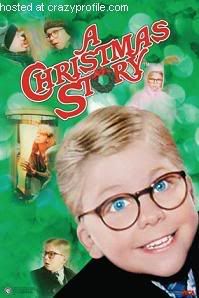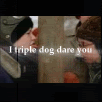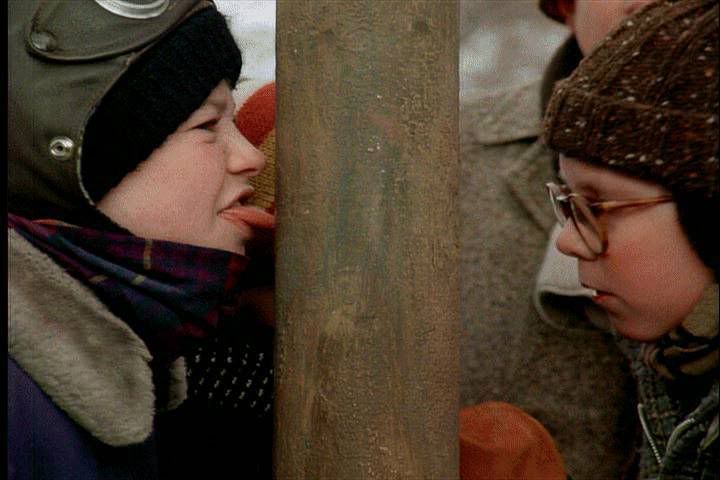
Plot
In regards to "Red Ryder Nails the Hammond Kid", "A Christmas Story" follows the same premises for its plot. Both, are humorous and light-hearted, but the movie includes many classic scenes in which everyone knows, including Flick getting his tongue stuck to the flag pole, "Oh fudge..", and the leg lamp. These scenes are not included in the short story, but rather help to make the movie longer. They are really not significant to the plot, although I believe the leg lamp symbolizes the origins of "Red Ryder Nails the Hammond Kid". I did some research, and the original publication of the story first appeared in Play Boy magazine, thus, the risque leg incorporates where the story first became famous. The movie also includes the narration of Ralphie as an adult, thus the diction of the storyteller is more wise than the voice of a child, similar to the story. Finally, the plot does not center around "Disarming the Toy Industry" as in the short story, rather it focuses on a boy's Christmas, and the involvement of the family.
Theme
Unlike the story, "A Christmas Story" does not end the flashback (it's not a complete flashback in the movie)/plot with "It worked!" (The "it worked" means Ralphie's plan to blame the injury to his cheek and broken glasses on a fallen icicle, rather than admitting the BB from his gun hit him). The movie continues after those words in which the narrator says "Life is like that. Sometimes at the height of our revelries...when all is most right with the world, the most unthinkable disasters descend upon us". At this point, the neighbor's numerous hounds come into the house and devour the Turkey, leaving the family with no Christmas meal. So instead, the family has Christmas dinner at the local Chinese restaurant This quote above incapacitates the theme. With events like Christmas, it does not really matter what occurs. Regardless, it is typical for families to celebrate the holiday and spend it with family. This can ultimately be compared with the short story in that the setting is the Great Depression. It does not matter that the families are lacking some essential needs, they are still going to continue with their traditions like seeing Santa, and exchanging gifts. The ending to the movie really ends this with a strong point. On Christmas night, it shows Mom and Dad enjoying the Christmas tree and the falling snow in the dark, while the children are nestled in their beds with their new toys. Some things never change.
Setting
The setting of "A Christmas Story" is similar to the short story, except that there is no beginning setting in New York, because Ralphie as an adult is disregarded in the movie. Also, the movie does not take place in the height of the Great Depression, rather the back of the cover considers it the 1940s. The Great Depression, is normally associated with the 1930s. However, the setting is still northern Indiana during the Christmas Season. What is important to the setting is the fact that it is Christmas time. Without this, Ralphie's desire for a "Red Ryder with a compass in the stock and the thing that tells time" would be irrelevant. It would make no sense to make this in July, because it would not build the story and suspense of, will he really get this item for Christmas. It also creates struggle for the character, because he has to get his point across that he really wants this toy for Christmas. It is also important that Ralphie is a child, because if he were an adult, the story would also be irrelevant. Then the Christmas magic would be lost.
Point of View
Ultimately, the point of view of "A Christmas Story" is first person from Ralphie's point of view. In a way, it could also be somewhat objective in that the movie is not seen from Ralphie's eyes, but from the audience. Meaning that the audience can see each of the characters reactions to events, they are not how Ralphie would have had them react. The main difference between the short story and the movie is that the flashback is different. In the movie, there is no physical flashback of a man looking back on a childhood Christmas. Rather, there is just his narration to the Christmas. As a fun fact, the narrator who voices Ralphie as an adult is ultimately the author of "Red Ryder Nails the Hammond Kid", Jean Shepherd. Ultimately, many parts of the narration are exactly from the script of the short story. For example, Ralphie says he wants '"a Red Ryder BB gun!"' Yet, he quickly retracts by saying "'I was just kidding. Even though Flick is getting one.'" Another difference between the movie and the story is that the movie includes short anecdotes. These anecdotes are Ralphie's imagination of if he had the Red Ryder, and making his parents feel guilty. They show the attention he desires, because many of his anecdotes display him as a hero.
Characterization
As in "Red Ryder Nails the Hammond Kid", the characters of Ralphie's Mom, Dad, teacher and Santa Claus help to advance the plot by telling Ralphie he will shoot his eye out with a BB gun. However, because it is a movie, the audience is able to see more of a relationship between Ralphie and these people. Although they have relationships with Ralphie and help to advance the plot, they still are rather static characters that can be described in one sentence. For example, Ralphie's mom cares for her children, and seeks the best for them, but finds humor in many of her family's situations. "A Christmas Story" also includes a more detailed involvement of Ralphie's friends. Although they are mentioned in the short story, they are displayed more in the parts that were added into the movie from the short story. They tend to show up in humorous parts of the story like Flick getting his tongue stuck to the pole, and occurrences with the neighborhood bully. It is plausible that children appear in many of the comical parts of the movie because it centers around light-hearted, holiday humor. 


Sunday, December 5, 2010
A Christmas Story
Posted by Lacey at 1:15 PM
Subscribe to:
Post Comments (Atom)

0 comments:
Post a Comment